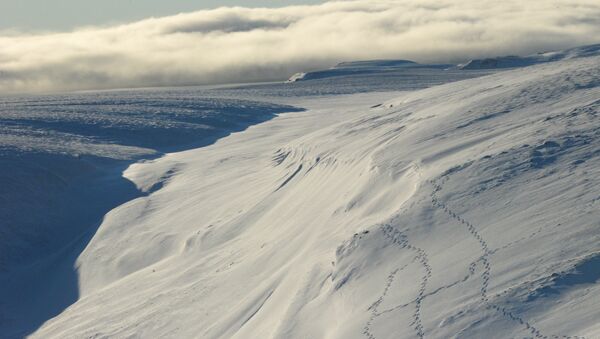Anja Rutishauser: I didn’t expect there to be any liquid water so it was kind of a happy accident. I was analyzing ice penetrating radar data to characterize the bedrock conditions underneath the ice and including the subglacial hydrology. I expected to find water maybe in those marine-terminating fast going outlet glaciers but certainly not in this cold space center of the ice caps. So when the radar data showed that there was liquid water that was quite a surprise.
Sputnik: Were you sure of your findings when you first saw this? Did you think that you were just making a mistake? How long did it take you to really confirm this and how long was it before the scientific community really caught onto this?
Anja Rutishauser: It definitely took a little bit for me to realize. I definitely did the analysis a couple of times to really convince myself that this is actually true. But then, because we know that the temperatures at the bottom of the ice were so cold, they’re about —10C, that’s why we didn’t expect there to be water. But then once we started thinking about the possibility that those lakes are hypersaline or contain salty water where the salt depresses the freezing point of the water allowing those lakes to sustain liquid even at those cold temperatures. That’s when we started to put the pieces together and realized that there really could be salty subglacial lakes there.
Sputnik: I understand that this lake is five times more salty than a salty ocean.
Anja Rutishauser: Yes it is four to five times the salinity of seawater.
Sputnik: And these are the first similar lakes with this kind of composition of the water.
Anja Rutishauser: Yes, there are over 400 subglacial lakes that had been found in Antarctica including Greenland. But these are believed to be freshwater, with water temperatures at around 0 degrees. So those are definitely the first ones in the Canadian Arctic and really unique because of their salty water. There is one other brine-rich water system that that has been found underneath the Cainer glacier in Antarctica. However, this is a very different system because it’s connected to a ground water system and it’s set by an ancient marine brine. So the Devon subglacial lakes are not connected to an ancient marine brine, so they’re likely more isolated. They are definitely very unique.
Sputnik: I can imagine that any marine life any life that could be found would also be very unique because they’ve been developing for it seems 120,000 years and in total isolation.
Anja Rutishauser: That 120,000 years is certainly a minimum of isolation. We don’t know if they might have been isolated for longer than that. It’s possible that there’s life in these subglacial lakes and so a subglacial aquatic environment has been shown to host active microbial life despite their isolation from the atmosphere in their extreme dark and cold conditions. So like you said the Devon subglacial lakes may be a unique ecosystem that could support microbial life.
Sputnik: Do you think that there could be more lakes located under the Canadian ice sheet?
Anja Rutishauser: There’s actually theoretical evidence that those lakes are surrounded by and underlined by salty rocks and we believe that those salty rocks are the first source of salinity. And so when we look on the geological map, across the Canadian Arctic there is an outcrop of similar salty rocks around other ice caps in the Canadian Arctic. So it’s possible that there are more such hypersaline subglacial water systems under other ice caps and maybe there’s more underneath marine-terminating outlet glaciers where the water might have pooled and the lakes have maybe run off into the ocean.
Sputnik: The conditions in these lakes may be similar to the conditions on other planets.
Anja Rutishauser: Exactly. So those subglacial lakes under the ice cap are particularly an analogue for Europa. And Europa is one of Jupiter's icy moons. It has a solid rock core and then an ocean which is covered by a global ice shell. So there’s evidence for a brine pocket or a brine lake within this ice shell on Europa. And so life that may exist on Europa could be under similar conditions like in those seven subglacial lakes where we have hypersaline water covered by ice. So exploring these subglacial lakes could help us to better understand the possibility and limitations of life in such extreme environments on Earth, but also on other planetary bodies like Europa.

